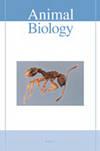稳定同位素表明受干扰地区驯鹿的身体状况下降
IF 0.9
4区 生物学
Q2 ZOOLOGY
引用次数: 1
摘要
了解干扰对个体健康的影响对野生动物管理很重要,对保护濒危物种也至关重要。我们比较了安大略省研究区39只林地驯鹿的健康状况和季节范围使用情况,并与它们的人类干扰水平进行了对比。我们之前的研究表明,受干扰地区的狼密度更高,这可能是由于人类改造的景观有利于驼鹿,驼鹿是狼的主要猎物。在本文中,我们讨论了三个目标。首先,由于饮食中氮的同化在很大程度上受到与压力相关的代谢过程的影响,我们假设氮同位素(N)的比率可能表明有蹄类动物的身体状况发生了变化,并且是健康状况变化的有用指标。其次,我们预测,在受干扰地区,狼捕食风险的增加将导致驯鹿身体状况的明显下降。第三,我们假设受干扰地区驯鹿体能下降的一个机制是狼活动增加,限制了驯鹿的季节性活动。我们发现驯鹿组织中氮的变化与脂肪评估的身体状况评分相关。我们使用GPS项圈来量化季节范围的使用,发现在使用无干扰区域的驯鹿中,适合度更高,季节范围重叠度更低。受干扰程度较高的地区冬季体能下降幅度较大。我们的研究确定了另一种机制,通过这种机制,人类干扰的景观对驯鹿健康的累积影响可能导致全球驯鹿数量的下降。本文章由计算机程序翻译,如有差异,请以英文原文为准。
Stable isotopes indicate reduced body condition of caribou in disturbed areas
Understanding the impacts of disturbance on individual fitness is important for wildlife management, and critical for the conservation of species at risk. We compared the fitness and seasonal range use of 39 woodland caribou in Ontario study areas contrasted by their level of human disturbance. We previously showed that wolf density in the disturbed site was higher, likely due to human-modified landscapes favoring moose, the primary prey of wolves. In this paper we address three objectives. First, because the assimilation of dietary nitrogen is heavily influenced by metabolic processes related to stress, we hypothesized that ratios of nitrogen isotopes (N) may indicate changes in body condition in ungulates and be useful proxies for changes in fitness. Second, we predicted that increased predation risk from wolves in disturbed areas would result in measurable declines in caribou body condition. Third, we hypothesized that one mechanism for fitness declines among caribou in the disturbed area was increased wolf activity restricting caribou seasonal movements. We showed change in N in the tissues of caribou was correlated with body condition scoring using fat assessment. We used GPS collars to quantify seasonal range use and found that fitness was higher, and seasonal range overlap was lower, in caribou using the nondisturbed area. Winter fitness declines were significantly larger in the more disturbed area. Our study identifies another mechanism by which the cumulative effects of human-disturbed landscapes on caribou fitness could contribute to global declines in caribou populations.
求助全文
通过发布文献求助,成功后即可免费获取论文全文。
去求助
来源期刊

Animal Biology
生物-动物学
CiteScore
2.10
自引率
0.00%
发文量
34
审稿时长
3 months
期刊介绍:
Animal Biology publishes high quality papers and focuses on integration of the various disciplines within the broad field of zoology. These disciplines include behaviour, developmental biology, ecology, endocrinology, evolutionary biology, genomics, morphology, neurobiology, physiology, systematics and theoretical biology. Purely descriptive papers will not be considered for publication.
Animal Biology is the official journal of the Royal Dutch Zoological Society since its foundation in 1872. The journal was initially called Archives Néerlandaises de Zoologie, which was changed in 1952 to Netherlands Journal of Zoology, the current name was established in 2003.
 求助内容:
求助内容: 应助结果提醒方式:
应助结果提醒方式:


